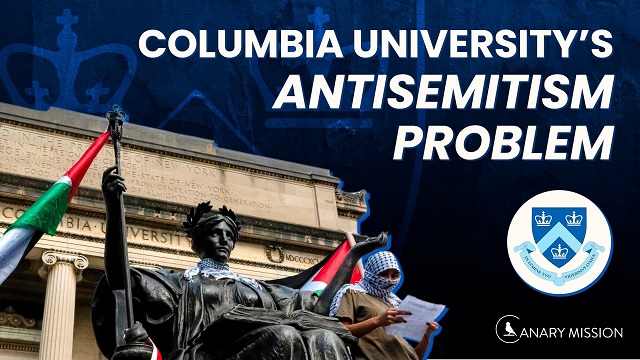
“Words have no power to impress the mind without the exquisite horror of their reality.” – Edgar Allan Poe
In my controversial novel, The Second Catastrophe: A Novel About a Book and its Author, the protagonist is a Professor, son of a Holocaust Survivor, who writes a book during the suicide bombings of the Second Intifada, claiming that a Second Holocaust has begun. He perceives that the genocidal nature of Iranian, Islamist and Arab attitudes to the Jewish Homeland, and the empathy of Western leftists with Arab and Iranian threats, along with the double standards used with respect to the Jewish state, are beyond mere dislike, and are approaching exterminationalism, fortunately stopped to date by Israeli military superiority.
How else can one understand the successes of the so-called Palestinians, where every evil act of terrorism increases support in Europe, America, and particularly in the universities, for the murderers, who in the world of intersectionality, are allowed to be “the oppressed” rather than the “oppressors”. Every time the Palestinians get to set the “narrative” by controlling the meaning of words like “occupied”, “oppressed”, “apartheid” and succeed in using words like “protest” to describe violent riots, then Israel and its friends lose another battle in this endless war about words where Hasbara seems almost as important as missile defense.
The writings on antisemitism are endless; the purpose of this contribution is to focus on contemporary attempts to split off anti-Israelism from the term antisemitism, so that genocidal attempts to create a second Holocaust can be viewed as having nothing to do with antisemitism. These attempts now come mainly from the Left, while so many Jews are locked into an atavistic framework where they say the only threats come from neo-Nazis and white nationalists, where it is obvious to me that the threats today are from leftist groups, together with their intersectional friends in BLM, and politicians in the U.S. like Ilhan Omar, Rashida Tlaib and Alexandria Ocasio-Cortez, who bring anti-Israel antisemitism to the younger supporters of the Democratic Party there.
I fear that a bright young 18 year old in the West who has ambitions to be a political and/or cultural leader, will, after a period of looking around the university, become a latter-day Alexandre Auguste Ledru-Rollin, a leader of the 1848 French Revolution, who is reputed to have declared, “There go my people. I must find out where they are going so I can lead them.” Today, they are eager to become “progressives” which involves anti-Israelism, rather than conservatives, because not many students want to conserve a world which the media has labeled “right wing”, especially when the best jobs are in the now-woke corporations, like High Tech censorial Zuckerberg’s and in education and government.
When the University of Toronto became the first university to host the bizarre “Israel Apartheid Week”, I wrote to then university President Naylor pointing out that whatever one thinks of Israeli responses to Arab terrorism and advocacy of genocide against Jews, the word “Apartheid”, given its essential ingredient in South Africa being complete separation of races, was in no way what is happening in Israel. There, Arab doctors work alongside Jewish doctors, Jewish and Arab patients receive equal medical care in adjoining beds, universities like Haifa University have one-third Arab students, and those Arabs who are willing (mostly Druze) serve in the army, the diplomatic corps and as Judges, alongside their Jewish colleagues. After the last election, Israel now has an Arab party in the governing coalition, whatever one thinks of that..
I wrote to him that a political dispute, whether as the Left says, is a dispute over land, or whether it is, as the Right says, an unwillingness by Islamists to allow a Jewish presence on any land ever controlled by Muslims, is not helped by distortion of facts.
I wrote to President Naylor (whose background was Medicine) that the issue was not one about free speech or diversity of opinion but was in my view one about the intellectual standards to be enforced by the University before allowing its space to be used for such an event. I asked him: “Would you allow a conference to take place at the University called “All U. of T. Professors are Fascists”? I suggested that he would not, and the reason is that we require our universities to meet certain standards of truth as to the facts underlying opinions. Otherwise, distorted facts and distorted opinions might well conduce, in this case, to the ideology of anti-Semitism. University events about Israel and the Jewish people using double standards, demonization or delegitimization, are anti-Semitic and there is no reason for the University to provide support.
Of course, I was unsuccessful in my argument, and now “Israel Apartheid Week” has spread to many if not most universities in Canada and the United States. At the same time, anti-Semitism sweeps the west and while Islamist Muslims hunt everywhere for evidence of “Islamophobia”, anti-Semitism in the West remains the most prevalent form of racial hatred.
As the University of Toronto refused to even discuss the issue with me, I became ashamed of my two degrees and returned them for cancellation. My background as a Lawyer, Historian and child of a Holocaust Survivor obviously makes me more sensitive than most people to certain ideologies and certain facts.
IN 2004, the great Soviet Jewish refusenik Natan Sharansky made yet another contribution to world Jewry. In a seminal essay in Jewish Political Studies Review, he outlined an important conceptual approach to antisemitism. He started his essay thus:
“When I was a dissident in the former Soviet Union, one of my regular activities was monitoring anti-Semitism, and smuggling out evidence and records of such activity to the West. I believed then that the free world, particularly after the Holocaust, would always be a staunch ally in the struggle against anti-Semitism.”
“Unfortunately, I was wrong. Today, as a minister in the Israeli government in charge of monitoring anti-Semitism, I find myself regularly summoning the ambassadors of West European states to protest anti-Semitic attacks on Jews in their countries and the often meek response of their governments…
“Whereas classical anti-Semitism is aimed at the Jewish people or the Jewish religion, ‘new anti-Semitism’ is aimed at the Jewish state. Since this anti-Semitism can hide behind the veneer of legitimate criticism of Israel, it is more difficult to expose. Making the task even harder is that this hatred is advanced in the name of values most of us would consider unimpeachable, such as human rights.
And so Sharansky came up with his “3D test” to distinguish legitimate criticism of Israel from antisemitism, as follows:
“The first “D” is the test of demonization. When the Jewish state is being demonized; when Israel’s actions are blown out of all sensible proportion; when comparisons are made between Israelis and Nazis and between Palestinian refugee camps and Auschwitz – this is anti- Semitism, not legitimate criticism of Israel.
“The second “D” is the test of double standards. When criticism of Israel is applied selectively; when Israel is singled out by the United Nations for human rights abuses while the behavior of known and major abusers, such as China, Iran, Cuba, and Syria, is ignored; when Israel’s Magen David Adom, alone among the world’s ambulance services, is denied admission to the International Red Cross – this is anti-Semitism.
“The third “D” is the test of delegitimization: when Israel’s fundamental right to exist is denied – alone among all peoples in the world – this too is anti-Semitism.”
Sharansky was particularly concerned about the antisemitism coming out of Muslim nations.
The extent to which his 3D Test is discussed less and less is the extent to which anti-Israel ideologues wish to separate anti-Israelism from its ideological foundation in antisemitism.
The next major initiative defining antisemitism arose from the International Holocaust Remembrance Alliance (IHRA).
Founded by a Swedish politician IHRA’s membership consists of 35 member countries, “each of whom recognizes that international political coordination is imperative to strengthen the moral commitment of societies and to combat growing Holocaust denial and antisemitism.”
The IHRA seeks to use trusted experts to “share their knowledge on early warning signs of present-day genocide and education on the Holocaust. This knowledge supports policymakers and educational multipliers in their efforts to develop effective curricula, and it informs government officials and NGOs active in global initiatives for genocide prevention.”
So far, so good. However, how does the IHRA define antisemitism and does it follow Sharansky’s concerns including the 3D test?
The IHRA says it worked to build “international consensus around a non-legally binding working definition of antisemitism. Note that this is “non-legally binding” and it is a “working definition”.
In 2016, it set out its working definition this way:
“Antisemitism is a certain perception of Jews, which may be expressed as hatred toward Jews. Rhetorical and physical manifestations of antisemitism are directed toward Jewish or non-Jewish individuals and/or their property, toward Jewish community institutions and religious facilities.”
Where is the recognition that current antisemitism is connected to anti-Israelism? The IHRA instead of mentioning the 3Ds as an integral part of the definition only gave as an example “the targeting of the state of Israel, conceived as a Jewish collectivity”, whatever that means, but it is sure to note that “criticism of Israel similar to that leveled against any other country cannot be regarded as antisemitic.
It did give 11 examples in total, and 6 of these examples related to Israel:
- Accusing Jewish citizens of being more loyal to Israel, or to the alleged priorities of Jews worldwide, than to the interests of their own nations.
- Denying the Jewish people their right to self-determination, e.g., by claiming that the existence of a State of Israel is a racist endeavor.
- Applying double standards by requiring of it a behavior not expected or demanded of any other democratic nation.
- Using the symbols and images associated with classic antisemitism (e.g., claims of Jews killing Jesus or blood libel) to characterize Israel or Israelis.
- Drawing comparisons of contemporary Israeli policy to that of the Nazis.
- Holding Jews collectively responsible for actions of the state of Israel.
Whether omitting Israel from the definition itself, detracts from the mentioning of 6 examples is a good question. But it seems to me that the IHRA was starting to feel the heat from so-called “progressive” organizations, including Jewish ones, because it noted in January 2021 that certain groups identified as the Progressive Israel Network were opposed to the codification of the working definition with its examples due to the “potential for misuse”. The groups were: Ameinu, Americans for Peace Now, Habonim Dror North America, Hashomer Hatzair World Movement, Jewish Labor Committee, J Street, New Israel Fund, Partners for Progressive Israel, Reconstructing Judaism and T’ruah.”Pledging that they “care deeply” for the State of Israel, they stated:
“the effort to combat antisemitism is being misused and exploited to instead suppress legitimate free speech, criticism of Israeli government actions, and advocacy for Palestinian rights. In particular, the effort to enshrine in domestic law and institutional policy the International Holocaust Remembrance Alliance (IHRA) Working Definition of Antisemitism, with its accompanying “contemporary examples,” risks wrongly equating what may be legitimate activities with antisemitism.
“This effort has created opportunities for abuse and politicization by the outgoing Trump administration and others, undermining the moral clarity of the effort to dismantle antisemitism.
“We respect the original creation of the IHRA Working Definition as an illustrative tool and as part of a larger and ongoing conversation about the nature of antisemitism. While we maintain no substantive objection to the core definition itself, our concern with its adoption as a legal tool is with the IHRA definition’s “contemporary examples,” which have been included as integral to the definition. We fear its adoption in law or policy at the state, federal and university level and in corporate governance has the potential to undermine core freedoms, and in some cases already has. For this reason, the Progressive Israel Network opposes the codification in US law or policy of the IHRA Working Definition of Antisemitism.”
And so, we see that the groups that call themselves “progressives” (but who I call “regressives”) are attempting to cleanse definitions of antisemitism of any reference to anti-Israelism despite Sharansky’s work.. It bothers me that we tolerate such groups claiming that they are Progressives, and that they stand for “progress.” Treating the Jewish Homeland as the (hated) Jew amongst the nations is indeed antisemitic. Tolerating the United Nations Human Rights Council with its explicit agenda to uniquely punish the Jewish people is also antisemitism, but the progressives ignore it at the same time as they “virtue signal” that they care deeply about Israel – which is surrounded by Iranian terrorist proxies and bloodthirsty Palestinians urged by the dictator Mahmoud Abbas again just this week to continue their “martyrdom” operations against Jewish civilians.
These “progressives” argue that former Secretary of State Pompeo’s declarations that “anti-Zionism is anti-Semitism” and that “the Global BDS Campaign [is] a manifestation of anti-Semitism” represent a harmful “overreach”. They say that this overreach is primarily aimed at shielding the present Israeli government and its occupation from all criticism. And they allege that such is made possible by the use of the Working Definition’s “contemporary examples.”
Alas, the Progressive network is so concerned with “overreach” that it fails to understand that in Israel’s neighborhood, under reach could be fatal. Jews have for so long been treated hatefully that sometimes, like abused persons, we sometimes blame ourselves inordinately: the Jewish right to live trumps the Jew-haters right to incite the death of another six million Jews in a Second Shoah, this time in our homeland. The clever students studying political theory, gender studies, and sociology, don’t know what the Torah says to do about Amalek and think that toleration of evil will somehow turn out well. (See my book, Tolerism: The Ideology Revealed.)
In a world where they practice “cancel culture” the Progressive network says that they insist that activists and academics that they support must have the right to express a wide range of political opinions without fear of being suppressed or smeared by the government. This includes critiques of the legitimacy of Israel’s founding or the nature of its laws and system of government. But it is only the anti-Israel positions of the radical left and its intersectional allies that are so supported by the progressives that they want them to be featured in any definition of antisemitism. It is only the progressives who view Israel’s very founding (and thus its existence”) as a “racist” endeavor.
I must say that I trust Sharansky’s work more than theirs. The fight against the vile BDS which if not countered and defeated could jeopardize the existence of the State of Israel, now surrounded by Iranian terrorist proxies and threatened with annihilation by the apocalyptic Iranian Mullahs. These groups would be trusted more if they would be as concerned with Israel hatred in the United Nations and the grave security threats exacerbated by anti-Israelism becoming the norm rather than the exception in Europe.
Most mainstream Jewish organizations belong to the Conference of Presidents of Major American Jewish Organizations in which 51 of its 53 member-groups have adopted the definition for their own use.
But to the progressives the mere mention of Israel in the examples as opposed to the more narrow 39 word text was enough to arouse their anger, showing the deep divide between the mainstream and the anti-Israel, pro BDS progressives. For example, Morriah Kaplan, strategic director at IfNotNow, which is focused on opposing the Israeli “occupation”, said of the organizations backing the definition, “these are not people I trust to go after antisemitism.”
The progressives tend to be those who we might term Trumpophobes, who could not accept any of Trump’s policies towards Israel or domestically to be valid. Since these progressives religiously are Reform, Reconstructionist, secular, or Renewal, the fact that Trump has an Orthodox Jewish daughter, son-in-law and grandchildren was not a reason to support Trump but to dislike him. Perhaps they sense that he is more certain than they are to have Jewish grandchildren.
Historian Deborah Lipstadt has been nominated to fill the vacant U.S. State Department’s Special Envoy for Combating and Monitoring Anti-Semitism. However her nomination has been held up due to some intemperate highly political comments she made. She, like so many Democrats, has been unable to put aside her Trumpophobia and keep politics out of the fight against anti-Semitism. As Jonathan Tobin recently noted in an essay in Jewish News Syndicate: Lipstadt may have deserved the post, but no one should be under any illusion that the decision didn’t have a lot to do with her willingness to play the partisan in 2020 by endorsing a shameful ad from the Jewish Democratic Council of America that likened the Trump administration to the rise of Nazi Germany. She followed that up by co-authoring an op-ed in The Washington Post in which she compared those who raised questions about the outcome of the 2020 presidential election to Holocaust-deniers. Tobin, although supportive of Lipstadt, acknowledged that she is an example of how “politics and combating anti-Semitism don’t mix”.
The intermarriage rates in America are now so high amongst progressives, there is a serious schism between the Orthodox and the Reform. (The Conservative or Masorti movement seems to be in a state of terminal decline) which is based on fundamental Halachic differences in addition to the views on Israel and antisemitism. Another is that progressive Jews and many in the mainstream view the modest number of extremists on the right, including white supremacists and neo-Nazis, as more of a problem than the antisemitism and anti-Israelism of the Left, including the intersectional Blacks and Islamists. The Left do not see the long term threat to our children and grandchildren posed by anti-Israel students, including Muslim Islamists whose aggressive behaviour is a feature of American universities. The Jewish Federations of North America sent a memo to the new Biden administration, outlining the organization’s priorities for fighting antisemitism. The document listed ISIS and Al Qaeda as threats to American Jews, but did not name right-wing antisemitism. The progressives were very upset. For example, Rabbi Alissa Wise, deputy director of Jewish Voice for Peace, which is anti-Zionist and supports the BDS Movement, said that seeing anti-Israel college students as more of a threat that right-wing antisemitism was to her “unconscionable”.
Public opinion polls show that American Jews are so inward looking that 75% said in an American Jewish Committee survey last year that the political right posed a serious antisemitic threat, compared to 32% who said the same about the political left.
“The IHRA definition is the most authoritative and internationally accepted definition of antisemitism,” said William Daroff, chief executive of the Conference of Presidents, as quoted by Forward .
But critics say that the definition is now being weaponized to shut down “legitimate” criticism of the Israeli occupation (sic) of what they call the West Bank and Israel’s friends call Judea and Samaria.
The progressives cannot tolerate even the mildest support for Israel, which recognizes that the Trump Plan for middle east peace and the Abraham Accords were together the best future for all. The “Peace to Prosperity” plan called for a demilitarized Palestinian state in all of Gaza, roughly 70% of the West Bank, and portions of Israeli land near those two territories. Roughly 30% of the West Bank would become part of Israel. The plan also called for wide scale economic cooperation across the region and a $50 billion investment to help Palestinians improve their education system, create 1 million new jobs, and establish reliable government institutions. The full plan can be seen here.
The fight over the definition of antisemitism and how much anti-Israelism is part of that antisemitism, is a sad commentary on the disunity of American Jewry. The election polls tell us that 70% of Americans in their support of Biden/Harris do not recognize the centrality of Israel, After the ill-fated Oslo Accords and the terrorism that Israel suffered as a result, Israelis moved politically to the right. An America whose Jews have, at the same time, moved to the left reflects that a hatred for Trump exceeds their love for Israel.
Hopefully they will start to understand that in Israel, the progressives have, according to Mordechai Nisan’s brilliant book, suffered The Crack-up of the Israeli Left. We can only hope that, like so many totalitarian regimes, based on lies, their movement that aims to hide the antisemitism inherent in anti-Israelism, will also end up in the dustbin of history.
©Howard Rotberg. All rights reserved.








